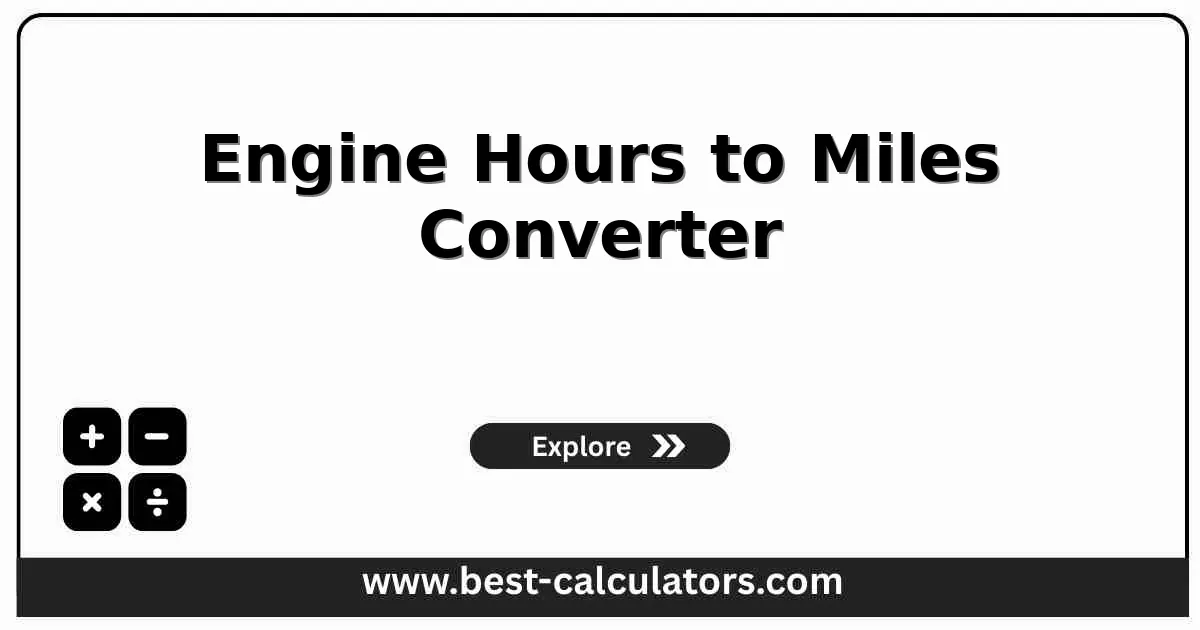Engine Hours to Miles Converter
Estimate driven miles, idle wear miles, and maintenance cycles from any engine-hour reading.
Engine Hour Inputs
Results
What is an Engine Hours to Miles Converter?
The Engine Hours to Miles Converter estimates how many road miles a vehicle or piece of equipment has effectively accumulated based on engine hours. It separates moving time from idle time so you can see both driven miles and “wear miles” from extended idling.
Fleet managers rely on this conversion when odometers under-report usage or vehicles spend long periods idling on site.
Compare results with the Commute Calculator for office travel, the Drive Time Calculator for scheduling, the Gas Calculator for budgeting fuel, and the Fuel Pump Calculator when planning upgraded delivery systems.
Best for:
- Police & EMS fleets - Gauge patrol car wear when lights and radios run for hours while parked.
- Delivery & utility trucks - Plan oil changes even when trucks sit idling at job sites.
- Construction equipment - Translate hours on generators, pumps, or skid steers into a mileage equivalent for resale.
- Boats & standby engines - Estimate wear on marine or backup engines without odometers.
How This Converter Works
Hours are split into productive (moving) hours and idle hours. Moving hours multiply by average speed to produce driven miles. Idle hours multiply by an “idle equivalency” factor such as 33 miles per idle hour to reflect additional wear.
Adding the two gives a maintenance-equivalent mileage total that you can compare to standard service intervals.
- Average speed should reflect real telemetry or driver logs.
- Idle percentage can come from ECM data or conservative estimates.
- Service cycles compare maintenance miles to your chosen interval.
Key Concepts Explained
Idle percentage
Portion of total hours spent idling; higher idle % means more wear without accumulating odometer miles.
Idle equivalency
Miles of wear per idle hour; OEMs often publish guidance for their engines.
Maintenance interval
Miles between oil changes or inspections—used to compute service cycles.
Weekly projection
Hours per week times average speed displays an ongoing mileage rate for scheduling.
How to Use This Calculator
Log engine hours
Enter the total hours shown on the meter or maintenance software.
Add speed & idle data
Use telematics, ECM downloads, or estimates for average speed and idle percentage.
Enter idle equivalency
Use the manufacturer-recommended miles-per-idle-hour factor or your fleet policy.
Compare to service interval
See when maintenance is due and how many cycles the engine has consumed.
Benefits of Using This Converter
- • Maintenance compliance – Trigger oil changes and inspections even when odometers lag behind real wear.
- • Resale transparency – Provide buyers with mileage-equivalent data for hour-based equipment.
- • Budget accuracy – Forecast fuel, service, and replacement schedules using consistent metrics.
- • Fleet benchmarking – Compare idle percentages across locations and teams to reduce wasted fuel.
Factors That Affect Your Results
- • Driving cycle – Urban stop-and-go vs highway routes change average speed dramatically.
- • Telematics quality – Better data yields tighter idle percentages and equivalency factors.
- • Ambient temperatures – Cold climates increase warm-up idle time.
- • Equipment type – Generators, police cars, and semi-trucks all use different idle equivalency factors.

Frequently Asked Questions
Why convert engine hours to miles?
Heavy equipment, police cars, delivery vans, and boats often track hours, not miles. Converting hours to equivalent miles helps follow maintenance schedules, resale valuation, and warranty limits.
How accurate is the conversion?
Accuracy depends on the average moving speed and idle percentage you enter. Using fleet telematics or trip logs for those values yields more reliable estimates than guessing.
What does idle equivalency mean?
Manufacturers often state that one hour of idle time equals 30–35 miles of wear. Enter the value recommended for your equipment so idle hours translate into “wear miles.”
Can I see weekly or annual mileage?
Yes. Enter average hours per week to display a projected weekly mileage figure. Multiply by weeks worked for annual estimates.
How do I use this for preventive maintenance?
Enter your standard service interval (e.g., 5,000 miles). The calculator shows how many equivalent miles you have accumulated and how many service cycles that represents.